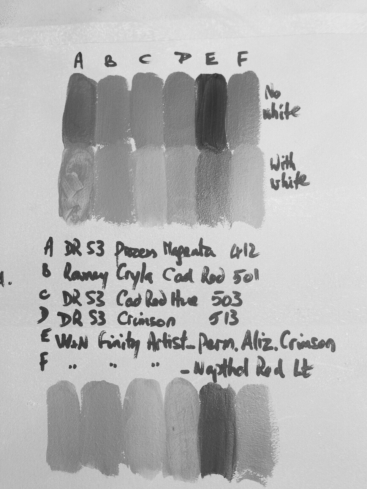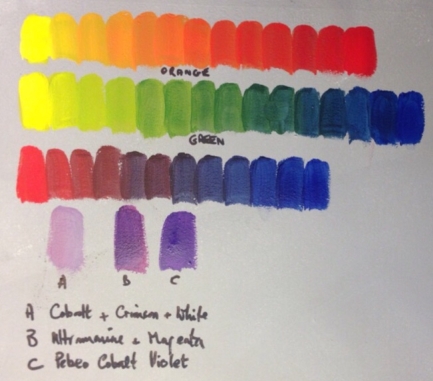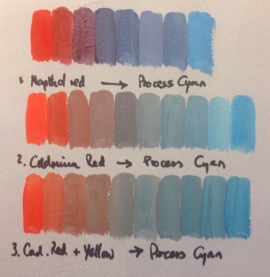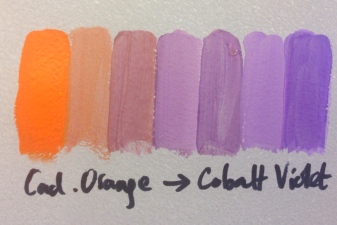In my acrylic paintbox I have a small range of colours but in several different makes, so as well as learning about the colours I was looking forward to learning about the differences between make and quality of paint.
Having completed the exercise using the paint neat (ie no water added), my conclusion was that the more expensive paints were more intense and more heavily loaded with pigment – a little went a long way. By contrast the cheaper paints (System 3) seemed ‘thinner’ and to have poorer covering ability, needing two or three coats to get a pure, flat swatch. My Pebeo colours, although inexpensive, seemed quite reasonable quality, definitely worth continuing with for now.
Here are my exercises, notes, thoughts and reflections:-
Yellows

It was immediately noticeable how transparent the Cadmiums were. Azo Yellow (W&N Finity Artists ) was easily the most intense. The Rowney Cryla was extremely thick and could hardly be used without dilution. I put a second coat on all – B and C were still transparent, even with a little white added, and needed 3 coats to cover the grey ground.
Hue – Process Y and Lemon Y were similar – quite cool. Cad Y were warmer, while Azo Y is between the two
Chroma (intensity) – the Cads were the least intense, most intense were Process and especially Azo. (but Process needed a couple of coats to build up to the same intensity).
Tone (light or dark) – the Cads are darkest in tone – especially Cad Yellow Hue, but this is because of the grey ground showing through. Azo is the lightest.
Changing the order of the colours –

Putting Cad Y Hue between Process and Azo revealed a big contrast between hue and intensity, with the Cad warmer and the other two much more intense by comparison.
Cad next to Lemon also revealed quite a big difference in colour temperature.
Reds – contrary to the course manual the Reds seemed more opaque than the yellows. I did make a second set of colour swatches with a speck of white (DR S3 Tit White) added but it almost seemed to have the effect of making the colours more transparent. The Finity Artists white (bottom row) performed better than the S3.


Hue – magenta and Aliz Crimson are fairly bluish-red. The Alizarin Crimson is almost purple. Napthol is more akin to the Cadmiums, warm with hint of orange. Crimson looked slightly bluish but not the rich colour I associate with Crimson. The colour most altered with the addition of white was the Crimson, which became a cool pink colour.
Chroma – the Cryla Cad Red is easily the most intense, and Aliz Crimson also intense. Least intense is Cad Red Hue.
Tone – Aliz Crim is very deep in tone, followed by Process Magenta. Lightest are Cad Red Hue and Napthol Red Lt.
Changing places –

I tried to compare opposites and thereby produce strong contrasts Intersetingly, Magenta is light when applied as a single coat as above – the tone is the same as the Cad Red Hue its next to.
Blues –
Initial observation when I put the first row of swatches down was the very poor covering quality of the S3 ultramarine compared to the Finity Ultramarine next to it. Laying down the next row, mixed with white as suggested, I was amazed at how the colour of the Process Cyan was suddenly revealed. The S3 Ultramarine was a very poor colour still, tempted to throw it away seeing it here.


Hue – Process, Indigo and Prussian are greenish. Ultramarine and Cobalt are warmer blues. The pure hue of Process Cyan is brought out when white is added. Indigo with white is quite a murky hue. Cobalt with white is a sky blue, ultramarine is a much richer, deeper colour.
Chroma – most intense is ultramarine. Cyan is also very intense, but needs white to bring out the colour. Cobalt and Prussian are less intense.
Tone – indigo, Prussian and Cyan are very dark. Cobalt is lightest.
Changing places –


Cyan with white contrasted highly in tone with Prussian (AF). A good colour temperature contrast would be Cyan with Ultramarine.
A lot depends on whether white is added and if so how much – tone can be infinitely adjusted.
Best primaries – I identified the best, purest primary colours, two of them made by mixing with a speck of another colour to correct the balance –

Scales –
With my primary colours I carefully made some scales aiming to transition smoothly from left to right.
At the beginning of the scales I only had to add a speck of the second colour to yellow to get the next hue. As I drew nearer the pure second colour I had to add increasing amounts of it to make a visible difference.
The first two scales produced clear secondaries – orange and green – in the middle. The colour in the middle of the red-blue scale is murky brown, not purple or violet. I made mixes with cobalt and alizarin Crimson, and with magenta and ultramarine and compared these to my pure cobalt violet.

Scales, maintaining tone –
This was difficult, even with the aid of a monochrome view on my phone camera, checking at each stage.


The photos show that on the yellow to red scale I got slightly dark in the middle, but overall it was quite accurate. Yellow to blue got more noticeably dark in he middle, but I corrected this towards the end
Red to blue was the most difficult, and I can see by squinting at the original that the last three positions are too light. The photos don’t show accurately all the nuances of tone though – it’s important to realise the camera itself sees in a particular way.





















